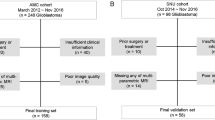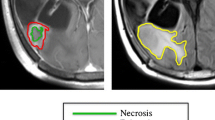Abstract
Purpose
To explore the feasibility and diagnostic performance of radiomics based on anatomical, diffusion and perfusion MRI in differentiating among glioma subtypes and predicting tumour proliferation.
Methods
220 pathology-confirmed gliomas and ten contrasts were included in the retrospective analysis. After being registered to T2FLAIR images and resampling to 1 mm3 isotropically, 431 radiomics features were extracted from each contrast map within a semi-automatic defined tumour volume. For single-contrast and the combination of all contrasts, correlations between the radiomics features and pathological biomarkers were revealed by partial correlation analysis, and multivariate models were built to identify the best predictive models with adjusted 0.632+ bootstrap AUC.
Results
In univariate analysis, both non-wavelet and wavelet radiomics features were correlated significantly with tumour grade and the Ki-67 labelling index. The max R was 0.557 (p = 2.04E-14) in T1C for tumour grade and 0.395 (p = 2.33E-07) in ADC for Ki-67. In the multivariate analysis, the combination of all-contrast radiomics features had the highest AUCs in both differentiating among glioma subtypes and predicting proliferation compared with those in single-contrast images. For low-/high-grade gliomas, the best AUC was 0.911. In differentiating among glioma subtypes, the best AUC was 0.896 for grades II–III, 0.997 for grades II–IV, and 0.881 for grades III–IV. In predicting proliferation levels, multicontrast features led to an AUC of 0.936.
Conclusion
Multicontrast radiomics supplies complementary information on both geometric characters and molecular biological traits, which correlated significantly with tumour grade and proliferation. Combining all-contrast radiomics models might precisely predict glioma biological behaviour, which may be attributed to presurgical personal diagnosis.
Key Points
• Multicontrast MRI radiomics features are significantly correlated with tumour grade and Ki-67 LI.
• Multimodality MRI provides independent but supplemental information in assessing glioma pathological behaviour.
• Combined multicontrast MRI radiomics can precisely predict glioma subtypes and proliferation levels.




Similar content being viewed by others
Abbreviations
- ADC:
-
Apparent diffusion coefficient
- ASL:
-
Arterial spin labelling imaging
- CBF:
-
Cerebral blood flow
- DWI:
-
Diffusion-weighted imaging
- eADC:
-
Exponential apparent diffusion coefficient
- FLAIR:
-
Fluid-attenuated inversion recovery
- T1C:
-
Contrast-enhanced T1-weighted images
- T2FSE:
-
T2-weighted fast-echo images
- VOI:
-
Volume of interest
References
van den Bent MJ (2014) Practice changing mature results of RTOG study 9802: another positive PCV trial makes adjuvant chemotherapy part of standard of care in low-grade glioma. Neuro Oncol 16:1570–1574
van den Bent MJ, Wefel JS, Schiff D et al (2011) Response assessment in neuro-oncology (a report of the RANO group): assessment of outcome in trials of diffuse low-grade gliomas. Lancet Oncol 12:583–593
Cancer Genome Atlas Research Network, Brat DJ, Verhaak RG et al (2015) Comprehensive, Integrative Genomic Analysis of Diffuse Lower-Grade Gliomas. N Engl J Med 372:2481–2498
Stupp R, Mason WP, van den Bent MJ et al (2005) Radiotherapy plus concomitant and adjuvant temozolomide for glioblastoma. N Engl J Med 352:987–996
Gerdes J, Lemke H, Baisch H, Wacker HH, Schwab U, Stein H (1984) Cell cycle analysis of a cell proliferation-associated human nuclear antigen defined by the monoclonal antibody Ki-67. J Immunol 133:1710–1715
Chen WJ, He DS, Tang RX, Ren FH, Chen G (2015) Ki-67 is a valuable prognostic factor in gliomas: evidence from a systematic review and meta-analysis. Asian Pac J Cancer Prev 16:411–420
Wakimoto H, Aoyagi M, Nakayama T et al (1996) Prognostic significance of Ki-67 labeling indices obtained using MIB-1 monoclonal antibody in patients with supratentorial astrocytomas. Cancer 77:373–380
Law M, Young R, Babb J et al (2006) Comparing perfusion metrics obtained from a single compartment versus pharmacokinetic modeling methods using dynamic susceptibility contrast-enhanced perfusion MR imaging with glioma grade. AJNR Am J Neuroradiol 27:1975–1982
Caulo M, Panara V, Tortora D et al (2014) Data-driven grading of brain gliomas: a multiparametric MR imaging study. Radiology 272:494–503
Inano R, Oishi N, Kunieda T et al (2014) Voxel-based clustered imaging by multiparameter diffusion tensor images for glioma grading. Neuroimage Clin 5:396–407
Krabbe K, Gideon P, Wagn P, Hansen U, Thomsen C, Madsen F (1997) MR diffusion imaging of human intracranial tumours. Neuroradiology 39:483–489
Garrett ME, Nauhaus I, Marshel JH, Callaway EM (2014) Topography and areal organization of mouse visual cortex. J Neurosci 34:12587–12600
Sui Y, Wang H, Liu G et al (2015) Differentiation of Low- and High-Grade Pediatric Brain Tumors with High b-Value Diffusion-weighted MR Imaging and a Fractional Order Calculus Model. Radiology 277:489–496
Kumar V, Gu Y, Basu S et al (2012) Radiomics: the process and the challenges. Magn Reson Imaging 30:1234–1248
Yip SS, Aerts HJ (2016) Applications and limitations of radiomics. Phys Med Biol 61:R150–R166
Avanzo M, Stancanello J, El Naqa I (2017) Beyond imaging: The promise of radiomics. Phys Med 38:122–139
Li Y, Liu X, Xu K et al (2018) MRI features can predict EGFR expression in lower grade gliomas: A voxel-based radiomic analysis. Eur Radiol 28:356–362
Kermany DS, Goldbaum M, Cai W et al (2018) Identifying Medical Diagnoses and Treatable Diseases by Image-Based Deep Learning. Cell Cell 172:1122–1131
Huang YQ, Liang CH, He L et al (2016) Development and Validation of a Radiomics Nomogram for Preoperative Prediction of Lymph Node Metastasis in Colorectal Cancer. J Clin Oncol 34:2157–2164
Vallières M, Freeman CR, Skamene SR, El Naqa I (2015) A radiomics model from joint FDG-PET and MRI texture features for the prediction of lung metastases in soft-tissue sarcomas of the extremities. Phys Med Biol 60:5471–5496
Aerts HJ, Velazquez ER, Leijenaar RT et al (2014) Decoding tumour phenotype by noninvasive imaging using a quantitative radiomics approach. Nat Commun 5:4006
Gillies RJ, Kinahan PE, Hricak H (2016) Radiomics: Images Are More than Pictures, They Are Data. Radiology 278:563–577
Louis DN, Ohgaki H, Wiestler OD et al (2007) The 2007 WHO classification of tumours of the central nervous system. Acta Neuropathol 114:97–109
Beesley MF, McLaren KM (2002) Cytokeratin 19 and galectin-3 immunohistochemistry in the differential diagnosis of solitary thyroid nodules. Histopathology 41:236–243
Jiang R, Jiang J, Zhao L et al (2015) Diffusion kurtosis imaging can efficiently assess the glioma grade and cellular proliferation. Oncotarget 6:42380–42393
Sahiner B, Chan HP, Hadjiiski L (2008) Classifier performance estimation under the constraint of a finite sample size: resampling schemes applied to neural network classifiers. Neural Netw 21:476–483
Zhou H, Vallières M, Bai HX et al (2017) MRI features predict survival and molecular markers in diffuse lower-grade gliomas. Neuro Oncol 19:862–870
Tien RD, Felsberg GJ, Friedman H, Brown M, MacFall J (1994) MR imaging of high-grade cerebral gliomas: value of diffusion-weighted echoplanar pulse sequences. AJR Am J Roentgenol 162:671–677
Lyng H, Haraldseth O, Rofstad EK (2000) Measurement of cell density and necrotic fraction in human melanoma xenografts by diffusion weighted magnetic resonance imaging. Magn Reson Med 43:828–836
Silva AC, Kim SG, Garwood M (2000) Imaging blood flow in brain tumors using arterial spin labeling. Magn Reson Med 44:169–173
Chawla S, Wang S, Wolf RL et al (2007) Arterial spin-labeling and MR spectroscopy in the differentiation of gliomas. AJNR Am J Neuroradiol 28:1683–1689
Kim HS, Kim SY (2007) A prospective study on the added value of pulsed arterial spin-labeling and apparent diffusion coefficients in the grading of gliomas. AJNR Am J Neuroradiol 28:1693–1699
Hwan-Ho C, Hyunjin P (2017) Classification of low-grade and high-grade glioma using multi-modal image radiomics features. 39th Annual International Conference of the IEEE Engineering in Medicine and Biology Society (EMBC), Seogwipo, 2017, pp. 3081–3084
Zhang X, Yan LF, Hu YC et al (2017) Optimizing a machine learning based glioma grading system using multi-parametric MRI histogram and texture features. Oncotarget 8:47816–47830
Lambin P, Rios-Velazquez E, Leijenaar R et al (2012) Radiomics: extracting more information from medical images using advanced feature analysis. Eur J Cancer 48:441–446
Thrall JH, Li X, Li Q et al (2018) Artificial Intelligence and Machine Learning in Radiology: Opportunities, Challenges, Pitfalls, and Criteria for Success. J Am Coll Radiol 15:504–508
Itakura H, Achrol AS, Mitchell LA et al (2015) Magnetic resonance image features identify glioblastoma phenotypic subtypes with distinct molecular pathway activities. Sci Transl Med 7:303ra138
Gevaert O, Mitchell LA, Achrol AS et al (2015) Glioblastoma Multiforme: Exploratory Radiogenomic Analysis by Using Quantitative Image Features. Radiology 276:313
Acknowledgements
We acknowledge Dr. M Vallières for his patient responses regarding the radiomics data post-processing. We also acknowledge Dr. Yang Fan from General Electric Company (China) for his generous contributions to manuscript revision. We also thank Dr. Xiaowei Chen (10 years’ experience) for his generous work in checking the VOIs.
Funding
This study has received funding by the National Program of the Ministry of Science and Technology of China during the “12th Five-Year Plan” (ID: 2011BAI08B10) and the National Natural Science Foundation of China (No. 81171308, No. 81570462, and No. 81730049)
Author information
Authors and Affiliations
Corresponding authors
Ethics declarations
Guarantor
The scientific guarantor of this publication is Wenzhen Zhu.
Conflict of interest
The authors of this manuscript declare no relationships with any companies whose products or services may be related to the subject matter of the article.
Statistics and biometry
One of the authors has significant statistical expertise.
Informed consent
Written informed consent was obtained from all subjects (patients) in this study.
Ethical approval
Institutional Review Board approval was obtained.
Methodology
• Retrospective
• Observational
• Performed at one institution
Electronic supplementary material
ESM 1
(DOCX 425 kb)
Rights and permissions
About this article
Cite this article
Su, C., Jiang, J., Zhang, S. et al. Radiomics based on multicontrast MRI can precisely differentiate among glioma subtypes and predict tumour-proliferative behaviour. Eur Radiol 29, 1986–1996 (2019). https://doi.org/10.1007/s00330-018-5704-8
Received:
Revised:
Accepted:
Published:
Issue Date:
DOI: https://doi.org/10.1007/s00330-018-5704-8




